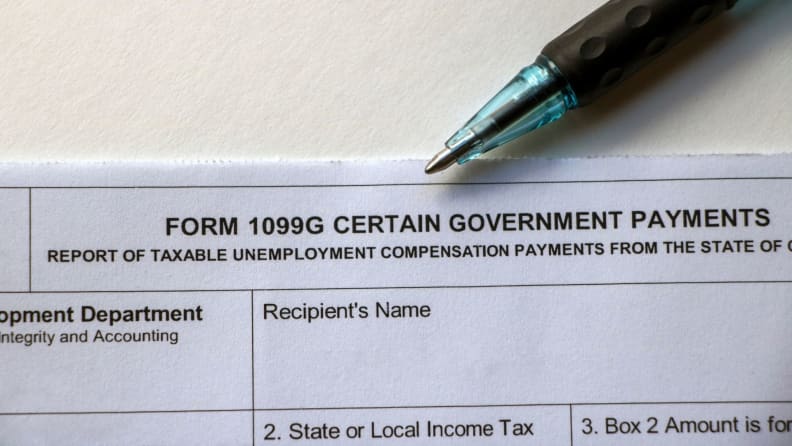File for unemployment? Here's what to expect with your 2020 taxes
This tax season is a little different for a lot of us.
 Credit:
Getty Images / SDI Productions
Credit:
Getty Images / SDI Productions
Recommendations are independently chosen by Reviewed's editors. Purchases made through the links below may earn us and our publishing partners a commission.
Throughout 2020, the coronavirus pandemic and its economic fallout forced thousands of businesses to lay off millions of Americans. By the end of the year, 6.7% of the U.S. workforce was unemployed.
Fortunately, many were able to apply for unemployment insurance benefits, which provide emergency cash to eligible people out of work. Recipients can use the money to cover things a paycheck normally would, like rent, bills, and groceries.
But just like a paycheck, the IRS generally considers unemployment benefits taxable income. Generally, you’re responsible for paying taxes on unemployment income at the federal level and potentially at the state and local level, too. If you filed for unemployment in 2020, here’s what to expect when you file your Form 1040 at tax time.
First, did you withhold taxes on your unemployment income?
The state doesn’t automatically withhold taxes. But when you apply for unemployment benefits through your state agency, you can ask them to withhold 10% of your compensation to cover your tax liability. Once you fill out Form W-4V, the agency deducts a percentage of your unemployment checks and puts it toward your federal income taxes. You’ll need to ask the agency how to withhold state income taxes.
If you don’t want to have taxes automatically withheld, you can pay quarterly estimated tax payments instead. The payment for quarter 1 and quarter 2 of 2020 was due on July 15, 2020. Third and fourth quarter payments were due on Sept. 15, 2020, and Jan. 15, 2021, respectively. (If you didn’t pay quarterly estimated taxes, we get to that below.)
Here’s some good news: The Federal Insurance Contributions Act (FICA) taxes—which support Social Security and Medicare programs—don’t apply to unemployment benefits, so you won’t need to worry about them when reporting your unemployment income. And if you received stimulus checks from the federal government in 2020, they’re not taxable either.
Look for this form in the mail

Keep an eye out for a 1099-G in your mailbox by the end of January.
If you received unemployment benefits in 2020, your state should send you a Form 1099-G that shows how much you received in unemployment. Box 1 tells you how much income you received, while Box 4 tells you how much federal income taxes were withheld. Boxes 10a–11 reports state income tax withholding.
You should receive this form via snail mail by Jan. 31, 2021. If you don’t receive one for some reason, you still need to report the income. Head to your state’s official website and look for the department that handles taxes. Check for an option to request a new form online, or call the unemployment agency. You’ll need to provide your personal information or the username and password you use to log in to your online account.
Report your 1099-G information

Using tax software? The online platform will attach the 1099-G to your federal and state returns.
Most of the information from Form 1099-G will go on Form 1040 (your main income tax form) and Schedule 1 (where you report special types of expenses or income, such as unemployment income).
- Report information from Box 1 on Line 7 of Schedule 1.
- Box 4 information goes on Line 25b of Form 1040 or Form 1040-SR.
- If you had state income taxes withheld, where you report the information varies with each state.
Attach a copy of your Form 1099-G to both your federal and state income tax return. Of course, if you’re using e-file software, they’ll walk you through these steps and will automatically do this for you. When we tested the best tax software this year, our fictional filer who received unemployment benefits—and did not withhold taxes—had a smooth experience.
A quick note here: If you worked part of the year, you might have to pay federal income tax on your regular wages, too.
You may owe federal, state, and local taxes
Generally, all taxpayers are liable for federal income taxes on unemployment income. That type of income includes funds received under programs like Federal Pandemic Unemployment Compensation (which added $600 a week to unemployment paychecks) and Pandemic Unemployment Assistance (PUA) (which expanded benefits to a wider pool of recipients).
Whether you have to pay state or local income taxes depends on where you live.
Some states don’t tax income at all, so you’re in the clear in Alaska, Florida, Nevada, South Dakota, Texas, Washington, and Wyoming. New Hampshire and Tennessee also give you a break here because they only tax investment income.
And six other states don’t tax unemployment benefits even though they have a state income tax: Alabama, California, Montana, New Jersey, Pennsylvania, and Virginia.
Indiana and Wisconsin may only tax a portion of your unemployment benefits.
You’ll also need to check the rules in your area. Some cities and counties have local income taxes that apply to unemployment compensation.
How to prepare for your tax bill

If you didn't withhold taxes from your unemployment benefits, you may end up with an outstanding bill for 2020.
The U.S. tax system is “pay-as-you-go,” which means you owe taxes on income as you earn it throughout the year. If you don’t pay enough, you could face a tax bill plus a penalty.
First, check whether you owe anything
Add up all of your income from 2020, such as wages, unemployment benefits, and retirement income. If it’s less than the standard deduction for your filing status, you might not need to file a tax return—and you’re not on the hook for paying taxes on unemployment income. For the 2020 tax year, the standard deduction amounts are:
- $12,400 for single filers and married couples filing separately
- $18,650 for heads of household
- $24,800 for married joint filers
What if you’re stuck with a tax bill?
If you end up owing the government, you should still file your income tax return by the deadline, which the IRS extended to May 17, 2021. However, your state return may be due as soon as April 15, so keep that in mind. You’re also required to pay your tax bill by the deadline—and if you don’t, penalties and interest will start accruing on any unpaid balance after this date.
Next, go over your options. The IRS offers several types of payment plans:
Short-term extension to pay: The IRS may agree to let you pay your bill up to 120 days after the deadline with no setup fees (though interest and penalties will accrue).
An installment agreement: You can enroll in an installment agreement, where you pay up to $50,000 owed over time. You’ll need to meet certain requirements—and interest, fees, and penalties may apply. Check Instructions for Form 9465 for details.
Offer in compromise: In some cases, you can ask the IRS to reduce your tax balance if you can’t pay the full amount. However, the qualification requirements are pretty strict.
Temporarily delay collection: You can also ask the IRS to delay collecting the amount you owe until you can pay. While you’re still responsible for the debt, you won’t have to pay it until your financial position improves. Penalties and interest will continue to accrue until you do pay.
Here’s how the IRS calculates interest and penalties
If you can’t pay your federal tax bill by the due date (which is May 17 this year) and you don’t make arrangements with the IRS, here are the penalties and interest you could face:
Penalties: The IRS charges a penalty of 0.5% on your balance due every month until the bill is fully paid. The penalty falls to just 0.25% if you enroll in an installment agreement.
Interest: You’ll also pay interest on the overdue balance. Interest rates are set quarterly and are usually based on the federal short-term interest rate plus 3%. The interest rate for underpayments is currently 4% and will compound daily.
Bottom line? If you filed for unemployment benefits in 2020, you may owe federal, state, or local taxes on those benefits. Ignoring the IRS isn’t a good option, as they’ll keep tabs on what you owe. But checking out your payment options can help if you’re still financially struggling—and it will save you from a major headache and a higher bill later.



